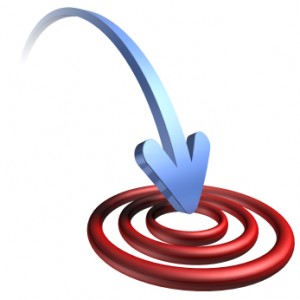What is Pin-Point change?
Pin-Point change is a simplified, three-step approach for affecting high-leverage, rapid business process improvement.
A pinpoint change comprises; 1) the identification of the single most critical and ineffective business process preventing the firm from achieving its objectives, 2) the identification of the specific process change needed, and 3) focusing, laser-like executive attention and decision-making on the few key people in the organization that must quickly change their behaviors to fix those ineffective processes. This does not necessarily mean removing or replacing them – unless, of course, they simply cannot or refuse to quickly learn and adjust behaviors.
What’s different about this approach to change is that to achieve the most rapid positive result, change is only required of a few strategically positioned people in the organization that are key links in the ineffective process – not the whole organization. Focus permits rapid change. Once the success of the change is proven, the rest of the organization typically falls in line, encouraged by both the initial success and the management intensity applied to the execution of the change. As a result all organizational change is faster.
An example:
The sales manager of a small, innovative health care products firm was convinced that the fastest road to sales growth was quickly setting up as many distributors as possible. He had charged his independent reps with the task of finding those distributors and directed the whole customer service team to respond quickly in setting up these new distributors when they called – credit checks, registration, setting them up in the system, getting them sales materials and servicing their other needs.
The number of distributors exploded – rapidly jumping into the hundreds. The customer service folks were overwhelmed servicing distributor requests, responding to inquiries and processing extremely small orders. In spite of this intense effort, sales results, as measured by sales per distributor, were poor.
The channel strategy and channel management process was broken – running wildly, un-steered and developing no traction.
Reversing this strategy by creating a single, national master distributor to which to send smaller distributors and distributor wannabe’s allowed the sales and customer service team to focus on the most important larger distributors, large end-user sales, lucrative growing market segments and most profitable products. After the channel strategy and process change, customer service productivity improved and revenue quickly turned upwards.
Changing the mind of just one person in this critical distributor management process was the key. The sales manager had to be convinced that his direction, process and behavior needed to change.
The ineffective process was channel strategy. The single person that needed to change behavior was the sales manager. One process, one behavioral change and one strategically positioned individual made the difference between success and failure.
The “Drive-Train” of any business:
A drive-train is the series of mechanical parts of an automobile that actually make it move. It starts with the engine, which in turn is connected to the transmission, which in turn is connected to the drive shaft, which in turn is connected to the read-end differential, which in turn is connected to the wheels through the rear axle. All this energy transfer goes on, beneath the visibility of the driver. All the parts of the drive train have to work together for the car to move. If any one of those segments of the drive train breaks, the car can’t move. The energy produced by the engine is lost before it gets to the wheels.
In most business units, the drive-train is the sequence of processes and people that makes the business run. In small to mid-size businesses, process-specific drive-trains typically operate two levels below the visibility of the business owner or executive in charge – yet these people-process drive-trains are the connections through which most business activity takes place.
The majority of day-to-day activity goes on beneath the awareness and visibility of executives. That’s actually good news – for the most part. It means the executive can get the flu on Sunday, stay home for the week, play golf on the weekend and return to work on Monday and notice the business hasn’t collapsed. The bad news is that processes in this chain, when broken or inefficient, continually produce weak or bad results. The executive sees less than optimum results in her business dashboard, but doesn’t know where the process is broken. It’s like the driver of a car, not understanding, when she presses down harder on the accelerator, why the car doesn’t seem to be move any faster.
A Typical Business Drive Train:
A typical business drive train might look like this. A sales person finds an opportunity. That sales person links to the inside sales and/or estimating team that produces a quote. That part of the drive-train, in turn, connects with the order entry people, who, once the customer decides to order, accepts the order and enters it into “the system”. The system then informs the production planner, the materials person, purchasing and the final link, operations – which in-turn builds and delivers that order. Then the “system” takes over and spits out an invoice. When the invoice is paid, accounts receivable enters the receipt into the “system” and deposits the check in the bank.
Each step is a mini-segment of the larger business process. But, because these drive-train links are more-or-less serial, one persistently ineffective segment will continually plague and corrupt the whole business.
In a small to mid-size business, at its most fundamental level, each drive-train segment comprises, the combination of a basic process and a key person.
Fast Change – Rapid Improvement:
The fastest three-step route to positive change comprises 1) the rapid identification of the inefficient or broken process in the business drive-train, 2) the identification of the specific process change needed and 3) the focus of management attention on the one individual through which behavioral change will be crucial.
I am continually amazed at how effective “the one process-one change-one individual” approach to improvement can be.
The steps of PinPoint change are straightforward:
1. Discover the broken process,
2. Identify the behavioral change needed,
3. Find the key individual whose behavior must be the first to change
One final consideration:
The one person that is critical to initiating all rapid behavioral change in a small-to-mid-size firm is the executive in charge. The speed of a drive-train change is only as fast as the decision on the part of the executive-in-charge to direct that change. A much higher probability of success exists, when the executive in charge, knowing what process is broken and what change is required, quickly identifies the key individual in the process and clearly communicates the expectation of what needs to be adjusted. An uncompromising insistence on the three-step approach is essential. Executive indecisiveness can hold it all back.
My advice to executives: Do not let the discomfort of insisting and confronting the need for behavioral change of a few key people in a critical drive train process jeopardize the well-being of all other employees and stakeholders.
It’s that fundamental.
Copyright The QMP Group, Inc. 2013 All Rights Reserved
*****
Click here to learn more about Marketing & Sales Organizational Tranformations led by Jerry Vieira and The QMP Group




 Success was demonstrated by a 15X greater Total Return to Shareholders than companies not practicing these business behaviors. Not only was their performance better, it was sustained over a longer period of time.
Success was demonstrated by a 15X greater Total Return to Shareholders than companies not practicing these business behaviors. Not only was their performance better, it was sustained over a longer period of time.